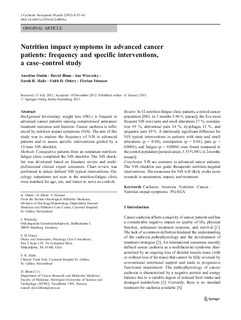| dc.contributor.author | Omlin, A. | |
| dc.contributor.author | Blum, David | |
| dc.contributor.author | Wierecky, J | |
| dc.contributor.author | Haile, SR | |
| dc.contributor.author | Ottery, Faith | |
| dc.contributor.author | Strasser, F | |
| dc.date.accessioned | 2019-10-28T08:01:38Z | |
| dc.date.available | 2019-10-28T08:01:38Z | |
| dc.date.created | 2013-12-03T13:27:32Z | |
| dc.date.issued | 2013 | |
| dc.identifier.citation | Journal of Cachexia, Sarcopenia and Muscle. 2013, 4 (1), 55-61. | nb_NO |
| dc.identifier.issn | 2190-5991 | |
| dc.identifier.uri | http://hdl.handle.net/11250/2624764 | |
| dc.description.abstract | Background
Involuntary weight loss (IWL) is frequent in advanced cancer patients causing compromised anticancer treatment outcomes and function. Cancer cachexia is influenced by nutrition impact symptoms (NIS). The aim of this study was to explore the frequency of NIS in advanced patients and to assess specific interventions guided by a 12‐item NIS checklist.
Methods
Consecutive patients from an outpatient nutrition‐fatigue clinic completed the NIS checklist. The NIS checklist was developed based on literature review and multiprofessional clinical expert consensus. Chart review was performed to detect defined NIS typical interventions. Oncology outpatients not seen in the nutrition‐fatigue clinic were matched for age, sex, and tumor to serve as controls.
Results
In 52 nutrition‐fatigue clinic patients, a mixed cancer population [IWL in 2 months 5.96 % (mean)], the five most frequent NIS were taste and smell alterations 27 %, constipation 19 %, abdominal pain 14 %, dysphagia 12 %, and epigastric pain 10 %. A statistically significant difference for NIS typical interventions in patients with taste and smell alterations (p = 0.04), constipation (p = 0.01), pain (p = 0.0001), and fatigue (p = 0.0004) were found compared to the control population [mixed cancer, 3.53 % IWL in 2 months (mean)].
Conclusion
NIS are common in advanced cancer patients. The NIS checklist can guide therapeutic nutrition‐targeted interventions. The awareness for NIS will likely evoke more research in assessment, impact, and treatment. | nb_NO |
| dc.language.iso | eng | nb_NO |
| dc.publisher | Wiley | nb_NO |
| dc.rights | Navngivelse-Ikkekommersiell 4.0 Internasjonal | * |
| dc.rights.uri | http://creativecommons.org/licenses/by-nc/4.0/deed.no | * |
| dc.title | Nutrition impact symptoms in advanced cancer patients: frequency and specific interventions, a case-control study | nb_NO |
| dc.type | Journal article | nb_NO |
| dc.type | Peer reviewed | nb_NO |
| dc.description.version | publishedVersion | nb_NO |
| dc.source.pagenumber | 55-61 | nb_NO |
| dc.source.volume | 4 | nb_NO |
| dc.source.journal | Journal of Cachexia, Sarcopenia and Muscle | nb_NO |
| dc.source.issue | 1 | nb_NO |
| dc.identifier.doi | 10.1007/s13539-012-0099-x | |
| dc.identifier.cristin | 1072050 | |
| dc.description.localcode | © 2013 The Authors. Published by John Wiley & Sons Ltd on behalf of the Society on Sarcopenia, Cachexia and Wasting Disorders This is an open access article under the terms of the Creative Commons Attribution‐NonCommercial License | nb_NO |
| cristin.unitcode | 194,65,15,0 | |
| cristin.unitname | Institutt for klinisk og molekylær medisin | |
| cristin.ispublished | true | |
| cristin.fulltext | original | |
| cristin.qualitycode | 1 | |

